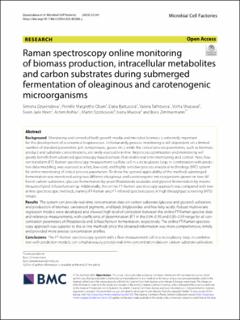| dc.description.abstract | Background Monitoring and control of both growth media and microbial biomass is extremely important for the development of economical bioprocesses. Unfortunately, process monitoring is still dependent on a limited number of standard parameters (pH, temperature, gasses etc.), while the critical process parameters, such as biomass, product and substrate concentrations, are rarely assessable in-line. Bioprocess optimization and monitoring will greatly benefit from advanced spectroscopy-based sensors that enable real-time monitoring and control. Here, Fourier transform (FT) Raman spectroscopy measurement via flow cell in a recirculatory loop, in combination with predictive data modeling, was assessed as a fast, low-cost, and highly sensitive process analytical technology (PAT) system for online monitoring of critical process parameters. To show the general applicability of the method, submerged fermentation was monitored using two different oleaginous and carotenogenic microorganisms grown on two different carbon substrates: glucose fermentation by yeast Rhodotorula toruloides and glycerol fermentation by marine thraustochytrid Schizochytrium sp. Additionally, the online FT-Raman spectroscopy approach was compared with two at-line spectroscopic methods, namely FT-Raman and FT-infrared spectroscopies in high throughput screening (HTS) setups. Results The system can provide real-time concentration data on carbon substrate (glucose and glycerol) utilization, and production of biomass, carotenoid pigments, and lipids (triglycerides and free fatty acids). Robust multivariate regression models were developed and showed high level of correlation between the online FT-Raman spectral data and reference measurements, with coefficients of determination (R2) in the 0.94–0.99 and 0.89–0.99 range for all concentration parameters of Rhodotorula and Schizochytrium fermentation, respectively. The online FT-Raman spectroscopy approach was superior to the at-line methods since the obtained information was more comprehensive, timely and provided more precise concentration profiles. Conclusions The FT-Raman spectroscopy system with a flow measurement cell in a recirculatory loop, in combination with prediction models, can simultaneously provide real-time concentration data on carbon substrate utilization, and production of biomass, carotenoid pigments, and lipids. This data enables monitoring of dynamic behaviour of oleaginous and carotenogenic microorganisms, and thus can provide critical process parameters for process optimization and control. Overall, this study demonstrated the feasibility of using FT-Raman spectroscopy for online monitoring of fermentation processes. | |
